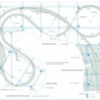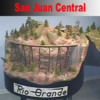Hi Eliot,
The San Juan Central has always been a favorite of mine.
The original in HOn3 was roughly 8'x10' with a 15" minimum radius.
Doubling everything to 16'x20' is a good rough estimate for the space required in On3, but that would only allow 30" minimum radius.
While I know you would not need anywhere near 48" radius, you may need more than 30", which would increase the space required. As you know, On3 engines usually take a wider radius than those On30 Bachmanns that are compromised in design to take HO 18" radius track.
I did some quick searching and saw a few references to the K-27 needing 36" or thereabouts.
What you'll have to do is first get a firm number on what those engines require, and then redraw the track plan using those curves as a minimum. This dinosaur still uses pencil, compass and ruler, but one of the software packages would give a more elegant plan.
Having a clean slate to start again can really be exciting. Looking forward to following your progress. 
Jim

















